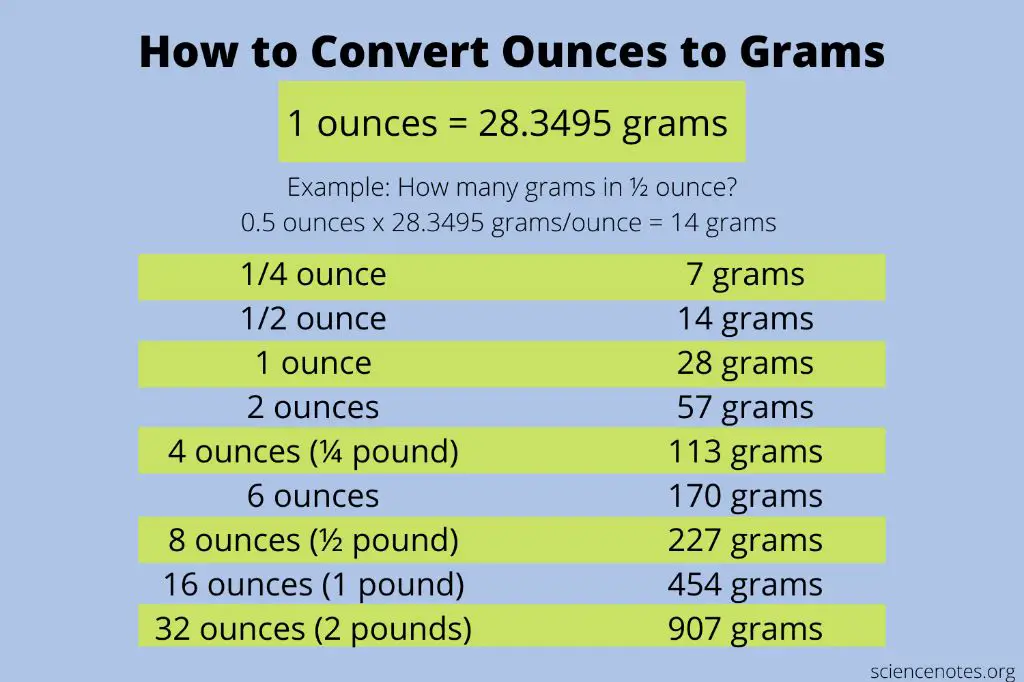How Do You Convert Grams To Dry Ounces?
Grams and ounces are units of mass used in the metric and imperial measurement systems, respectively. Grams belong to the metric system which is used universally in science. Ounces are part of the imperial system which is still used in the United States in applications like cooking. Knowing how to convert between grams and ounces is useful for recipes, nutrition labels, cooking, and other everyday applications.
For example, a recipe may list ingredients in ounces but if you only have a kitchen scale that measures in grams, you’ll need to be able to convert the measurements properly. Nutrition labels on food packages are required to list nutrient amounts in both metric and imperial units. Being able to move between the two allows you compare products more easily. In scientific contexts, metric units like grams are used so any imperial measurements would need to be converted to carry out calculations. Overall, knowing how to convert between grams and ounces provides flexibility when dealing with quantities in different measurement systems.
The Metric System
The metric system is a system of measurement that uses the meter, liter, and gram as base units for length, volume, and mass/weight respectively. The system was first proposed in France in 1791 and is based on decimal multiples and fractions of the base units. Over the years, the metric system has been adopted by most countries around the world, with the notable exceptions of the United States, Liberia, and Myanmar.
Grams are one of the core base units of the metric system used to measure mass. One gram is defined as the mass of one cubic centimeter of water at 4°C. Grams are frequently used in everyday life to measure the mass and weight of food items, products, and other objects. The gram allows for easy conversions using multiples and fractions – one kilogram is equal to 1000 grams while one milligram is 1/1000th of a gram. Grams relate to other metric units in predictable ways, unlike Imperial system units. The wide adoption of the gram as a base unit provides consistency in measurement across many contexts worldwide.
According to the Encyclopedia Britannica, the metric system was first conceived during the French Revolution to establish a universal system of measurement based on natural constants and units that could be used by all people.
https://www.britannica.com/science/metric-system-measurement
The Imperial System
The imperial system, also known as the US customary system, is a collection of measurement units that were historically used in the British Empire and countries in the former empire. The system includes units such as ounces, feet, miles, gallons, and degrees Fahrenheit.
The imperial system has origins dating back to Roman times, but it was formally established in the British Empire in 1824. At the time, a variety of local units were in use throughout the empire. The imperial system helped to standardize measurements across the British Empire. It was later adopted in countries such as the United States that were former British colonies.
Ounces are a unit of mass in the imperial system. There are several types of ounces, including fluid ounces for volume and ounces for mass or weight. The most common ounce used today is the avoirdupois ounce, which is equal to 28.3495231 grams. This is the standard ounce used today in the United States and the former British Empire for measuring mass or weight.
The imperial system has largely been replaced by the metric system around the world. However, ounces and some other imperial units are still commonly used in the United States in particular for measurement. Understanding how to convert between imperial and metric units remains relevant for recipes, measurements, and international trade.
Sources:
Imperial units | History, Measurements, & Facts – Encyclopedia Britannica
Units of Mass
Grams and ounces are both units used to measure mass. Mass is a measure of the amount of matter in an object, while weight is a measure of the force of gravity on an object. Though related, mass and weight are fundamentally different quantities.
Mass is an intrinsic property of matter that is constant and unchanging. The mass of an object remains the same regardless of its location. Weight, on the other hand, depends on the strength of the gravitational force. An object’s weight changes depending on its location. For example, an object weighs slightly less on the moon than on the Earth because of the moon’s lower gravity. However, the object’s mass stays the same.
Since mass is constant, it is generally preferred over weight as a measurement in science. Mass allows precise comparisons between objects and accurate calculations using physics formulas. Grams and ounces are standardized units for precisely measuring mass. One ounce is defined as exactly 28.3495 grams. To convert between grams and ounces, a simple unit conversion calculation is used based on their defined mass relationship.
For more on the differences between mass and weight, see this overview from ThoughtCo: https://www.thoughtco.com/mass-and-weight-differences-606116
Grams to Ounces Conversion

The basic conversion between grams and ounces is:
1 gram = 0.03527 ounces
This conversion comes from the definitions of the gram and ounce units. The gram is defined based on the kilogram, which is the base unit of mass in the metric system. One kilogram is defined as equal to 1000 grams.
The ounce is a unit of mass in the imperial system. Specifically, it is the avoirdupois ounce, which is defined as equal to 28.349523125 grams.
So if 1 ounce = 28.349523125 grams, then dividing both sides by 28.349523125 gives:
1 gram = 0.03527396195 ounces
Rounding to 5 decimal places gives the commonly used conversion:
1 gram = 0.03527 ounces
Knowing this basic conversion allows you to convert any number of grams to ounces by multiplying the grams by 0.03527. For example:
25 grams x 0.03527 oz/g = 0.88175 oz
So 25 grams = 0.88175 ounces.
Ounces to Grams Conversion
The basic conversion between ounces and grams is:
1 ounce = 28.35 grams
This conversion comes from the metric system definitions of units. The gram is the base unit of mass in the metric system, while the ounce is a unit of mass in the imperial system.
Specifically, one ounce is defined as exactly 28.34952 grams. This exact conversion factor between ounces and grams was established internationally in 1959.
So in summary, if you have a quantity in ounces, you can convert it to grams by multiplying by 28.35. For example, 14 ounces equals approximately 396.9 grams (14 x 28.35 = 396.9).
To convert any quantity in ounces to grams, simply multiply the ounce amount by 28.35. This gives you the equivalent number of grams.
Converting Measurements
The basic conversion between grams and ounces is:
1 ounce = 28.3495 grams
To convert grams to ounces, you simply divide the number of grams by 28.3495.
For example, to convert 50 grams to ounces:
50 grams / 28.3495 grams per ounce = 1.765 ounces
To convert ounces to grams, you multiply the number of ounces by 28.3495.
For example, to convert 5 ounces to grams:
5 ounces x 28.3495 grams per ounce = 141.75 grams
You can use this basic conversion to convert any number of grams to ounces or ounces to grams. The key is dividing by 28.3495 when going from grams to ounces, and multiplying by 28.3495 when going from ounces to grams.
Here are some more examples:
100 grams / 28.3495 = 3.5274 ounces
10 ounces x 28.3495 = 283.495 grams
As you can see, the conversion allows you to easily calculate equivalent gram and ounce measurements.
Converting Recipes
When following recipes, it’s common to need to convert between metric and imperial units, especially grams and ounces. Here are some tips for converting recipe measurements between grams and ounces:
Use a simple conversion: 1 ounce = 28.35 grams. So to convert:
– Ounces to grams: multiply ounces by 28.35
– Grams to ounces: divide grams by 28.35
For convenience, use a grams to ounces converter. Input the grams or ounces, and it will instantly convert between the two units.
When scaling recipe quantities up or down, first convert all measurements to the same unit before adjusting the amounts. For example, if a recipe calls for “2 ounces chocolate, 60 grams flour” and you want to double it, first convert ounces to grams:
– 2 ounces chocolate x 28.35 grams per ounce = 56.7 grams chocolate
– 60 grams flour
Then double the amounts:
– 113.4 grams chocolate
– 120 grams flour
Be careful when converting volumes like cups or teaspoons between grams and ounces. The conversion depends on the density of the ingredient. Instead, weigh the ingredient directly on a kitchen scale for the most accurate measurement.
When shopping, use the unit specified on the packaging. For example if a recipe lists 225 grams of butter but packages at the store list ounces, multiply 225 grams x 0.03527 ounces/gram to get the amount in ounces.
Converting Product Packages
When looking at product packaging, you may notice that some brands list the weight or volume using metric units while others use imperial units. It’s helpful to be able to convert between the two systems when comparing products.
Here are some examples of common food packaging conversions:
- Flour – 1 kg = 2.2 lbs
- Sugar – 250 g = 8.8 oz
- Milk – 1 liter = 1.06 quarts
- Vegetable oil – 500 ml = 16.9 fl oz
- Cereal – 340 g = 11.9 oz
Other types of products like paper towels, aluminum foil, and bottled beverages also often list both metric and imperial units for comparison. Knowing the approximate conversions can help you quickly determine if you’re getting a better deal on a different sized package. When accuracy really matters, you can use an online metric conversion calculator to convert the units precisely.
When Accuracy Matters
Rounding during conversions can impact accuracy for sensitive measurements. In fields like engineering, construction, and science, accuracy is critically important when taking measurements and performing conversions between units. An inaccurate conversion could lead to catastrophic failures down the line. For example, when constructing a building or bridge, a small error in a measurement conversion could cause the structure to be unstable. In physics experiments, imprecise conversions could completely invalidate results.
To maintain accuracy when converting measurements:
- Avoid rounding during intermediate steps of a conversion. Only round at the very end.
- Use all available digits when multiplying or dividing. Don’t prematurely truncate values.
- When adding or subtracting, maintain the same number of decimal places as the least precise measurement.
- Carefully track units throughout every step of the conversion.
- Double check your work to catch any arithmetic errors.
Following these best practices will help minimize rounding errors and ensure the most accurate final converted value. For the highest precision, avoid converting units altogether by taking measurements directly in the desired units when possible.
Sources:
https://www.quora.com/What-is-the-importance-of-converting-units-of-measurement




